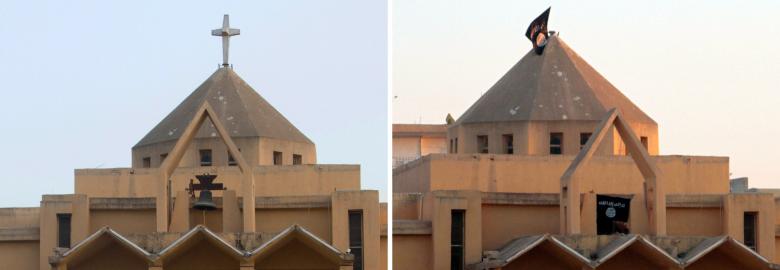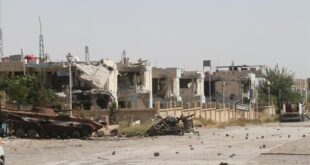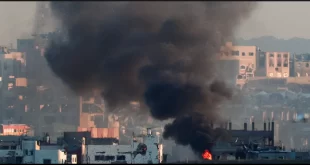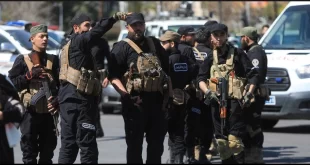
Mar 26, Al Akhbar
The Syrian town of Kessab, once a popular holiday destination, has recently come under heavy gunfire from rebel groups linked to al-Qaeda. Armed men entered the town, looted Armenian shops and homes, taking families hostage, and desecrating the town’s three churches.
The attack has forced at least 2,000 ethnic Armenian civilians to seek refuge in Latakia and other neighboring hills. For Syria watchers, this incident further highlights the systematic targeting of Christian communities in the country.
Part of an ancient civilization that extends from the Syrian coast up to the valley of the Orontes River, Kessab is located in the far northern countryside of Latakia, 2 km south of the Turkish border and 7 km east of the coastline. The majority of the population in Kessab and the surrounding region are descendants of the survivors of the Siege of Antioch (Antakya), which took place in the thirteenth and fourteenth centuries. Many Antochians, predominantly ethnic Armenians, fled Ottoman persecution and found refuge in more mountainous regions, such as Kessab. Centuries later, in 1915, fleeing massacres at the hands of Ottoman Turks, more Armenians found refuge in Kessab while others perished in the desert of Deir el-Zor and toward the south of the Jordanian desert.
Almost a hundred years after the Armenian Genocide of 1915, the AKP government of Prime Minister Recep Tayyib Erdogan appears to have proven William Faulkner’s saying: “The past is not dead. In fact it is not even past.”
Turkey intervened in the Syrian crisis from its early stages. Erdogan – along with other countries – provided anti-regime forces safe havens inside Turkish territories and turned a blind eye to the influx of foreign fighters into Syria, including some from Chechnya and other Central Asian countries. Those fighters currently form the strongest elements of the Islamic State in Iraq and the Levant (ISIS) and other al-Qaeda affiliated groups.
While Syrian-Armenian parties did not participate in the ongoing war – apart from young Syrian-Armenians who are conscripted into the army – the Armenian community was not spared from the systematic targeting of ethnic and religious minorities by anti-government forces, such as the St. Kevork Church in Aleppo, the Armenian Catholic Church in Raqqa, among many other churches, schools and institutions.
The Syrian government, as well as several Armenian websites, reported the recent cross-border attacks were waged from three border points inside Turkish territories. According to security sources in Kessab, the attacks were waged under heavy artillery cover by the Turkish army, while the injured were being treated in the city of Yayladagi in Turkey, which borders Syria.
Three days before the assault on Kessab, the leader of Turkey’s opposition Republican People’s Party (CHP), Kemal Kilicdaroglu, called on Chief of General Staff General Necdet Ozel “not to embark on an adventure” with a military intervention in Syria, saying that “He [Prime Minister Recep Tayyip Erdogan] could decide to move the army into Syria before the elections.”
Kilicdaroglu’s prediction seems to have come true when the Turkish air force gunned down a Syrian warplane on March 23, in an area where al-Qaeda affiliated groups have been battling the Syrian Army and National Defense Forces (NDF) over control of a border crossing. PM Erdogan congratulated his army in an election rally in northwest Turkey.
Analysts believe this could be Erdogan’s last card before local elections in Turkey take place on March 30. Some Syrian observers believe this escalation on the part of Turkey is a provocative act aimed at dragging both armies into a direct confrontation in order to mobilize the Turkish public and regain some of the support Erdogan lost in the last few months as a result of the corruption scandals and restrictions on media freedom. With Erdogan’s popularity in decline, he is seemingly hoping to export the internal crisis abroad to gain a moral victory which could help him in the upcoming elections.
Abdoullah Ali, an expert on Islamic groups in Syria, confirmed the takeover was headed by Abou Mousa al-Chechani (Chechnyan), among other senior and experienced fighters who had previously fought in Afghanistan, Bosnia, Chechnya and Iraq, thus indicating the importance of this battle.
Kessab was the only city bordering Turkey that was controlled by the Syrian government. Syrian-Armenian war correspondent Sarkis Kassargian believes taking control of Kessab means taking control of the border crossing with Turkey, which allows anti-government fighters to advance toward the coastline, and in turn strengthen their position on the ground. In addition, the alleged capture of Samra village by rebel forces grants them access to the highest point in the village.
An influential Washington-based Armenian advocacy group, the Armenian National Committee of America (ANCA), has condemned the “onslaught on Kessab” and accused Turkey of facilitating the infiltration of radical groups in their attacks on Christian and other minority populations in Kessab. The group has also called on the US administration and Congress to pressure Ankara to end its support for “the destruction of Kessab.”
“For months, we have warned the international community of the imminent threat posed by extremist foreign fighters against the Christian minority population in Syria,” the group said, in a statement. “These vicious and unprompted attacks against the Armenian-populated towns and villages of Kessab are the latest examples of this violence, actively encouraged by neighboring Turkey. We call upon all states with any influence in the Syrian conflict to use all available means to stop these attacks against the peaceful civilian population of Kessab, to allow them to return to their homes in safety and security.”
After targeting the Armenian-populated villages of Ghnaymiyeh and Yaakoubiyeh, it is now the turn of Kessab, from which some 670 Armenian families fled to Latakia under the protection of the Syrian Army. Armenians who were displaced from Aleppo to Kessab have found themselves homeless yet again in Latakia. “Is this is our destiny?” many Armenians are now wondering.
 Syria Support Movement solidarity with the Syrian people
Syria Support Movement solidarity with the Syrian people




